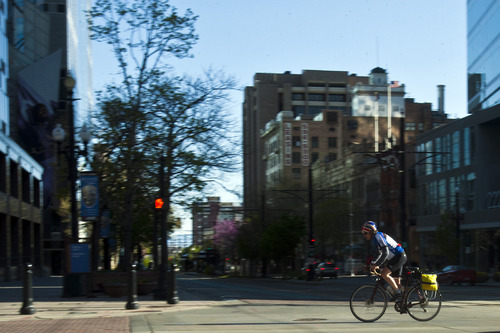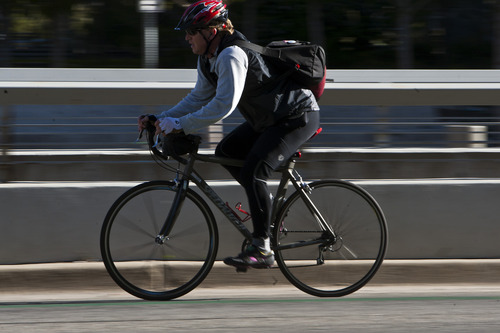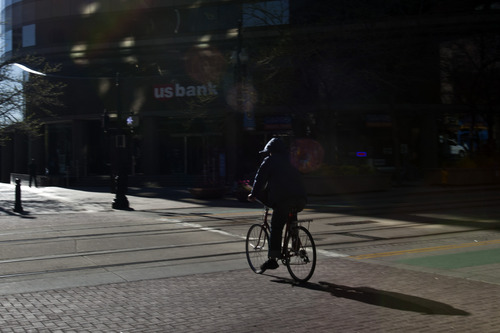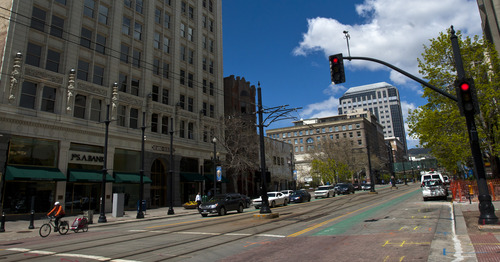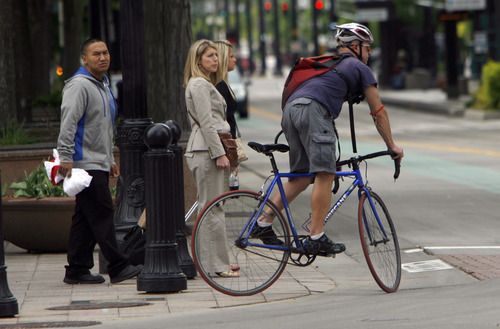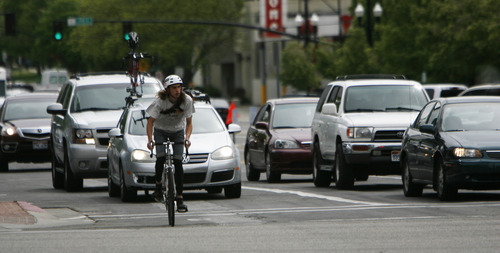This is an archived article that was published on sltrib.com in 2013, and information in the article may be outdated. It is provided only for personal research purposes and may not be reprinted.
As Salt Lake City tries to be friendlier to bicyclists, police are issuing fewer citations to two-wheeled commuters.
According to data from the Salt Lake City Police Department, 2012 saw the lowest number of bike-related citations in five years. Last year, for example, police issued cyclists 48 moving violations, tickets usually related to breaking traffic laws.
That number was significantly lower than 2011, which saw 71 violations. In 2010, the peak year for most categories of bike citations in the past five years, police wrote 104 moving violations to cyclists in the city.
It's unclear how many more cyclists are obeying the rules of the road, but the city has shifted its focus from outright punishment to education and outreach, according to Salt Lake City Transportation Planner Colin Quinn-Hurst.
"I think [the drop in citations] reflects our new focus on education and enforcement," Quinn-Hurst said.
Starting in 2012, the city transportation department and police paired to dole out more education materials and warnings than just tickets. One program targeted cyclists who were riding at night without any lighting gear. Police issued warnings along with free bike lights to the cyclists they stopped, Quinn-Hurst said.
Transportation officials also made their presence known at public events, handing out cards with bike laws printed on them and safety brochures.
"We're trying to give [cyclists] all the resources they need ... without scaring them away from bicycling," Quinn-Hurst said.
In the past two years, city officials have had to accommodate a lot more cyclists. Salt Lake City saw a 30 percent increase in the number of bikes on the road in that time period, Quinn-Hurst said. He hopes the mentality on the roads will change as that number continues to grow.
In fact, Quinn-Hurst cited a 2003 study that showed the number of crashes between motorists and cyclists actually tends to go down or stay static as the number of bikers increases.
Christy Jensen, a bike mechanic at the downtown Saturday Cycles shop, said she's felt safer on the streets while living in the city for the past three years, and she attributes that to improving infrastructure and cyclists getting better educated about the rules of the road.
Jensen said there still seems to be a clash between aggressive motorists and bikers who "act like salmon" darting between cars in the streets, but Jensen said that clash is starting to erode in Utah's capital.
Jensen, who grew up in Japan, says it is possible for pedestrians, cyclists and drivers to get along, even in large cities. They just have to get used to each other.
"It would be nice to have a more symbiotic relationship, but I think it will come with time," she said.
Tom Millar, a transportation planner for Alta Planning and Design who rides his bike every day, said that as more people take to cycling in the city more of them are paying more attention to the rules. For his part, Millar has tried to be more courteous.
"I just need to prove that not all bicyclists are law-breaking, 20-year-old ruffians," he said.
Salt Lake City Police Detective Lisa Pascadlo says that despite the drop, there is still a problem with both cyclists and motorists failing to obey the law.
"Everyone who uses the road needs to do a little bit better job of getting along with each other," she said.
Pascadlo would know. When she's not in uniform, she's often riding a bicycle herself. She sees some of the hostility cyclists get from some motorists. Sometimes drivers will deliberately brush by as closely as they can, or yell at her to get off the road.
Pascadlo said the most dangerous example of rule-breaking is when motorists pass her on the left and suddenly cut her off to make a right turn. But hostile drivers aren't the only ones at fault. Cyclists blatantly disobeying traffic laws don't help, Pascadlo said.
"People get on their bikes and forget that they're actually a driver," she said.
Pascadlo sees as part of her job to act as an "ambassador" for other cyclists.
"I try to inform other people by doing things the right way," she said.
The most common problem is when cyclists blast through stop signs and stop lights, Pascadlo said. Sometimes, if she sees a fellow cyclist do something like that, she'll ask: "Would you do what you just did in your car?" Usually the answer is no.
"So why are you doing it on your bike?" she asks. So far, she hasn't gotten a good answer.
On Monday night, a 53-year-old man who was crossing against a red light in the busy intersection of 500 South and 500 West was struck by a vehicle headed to the on-ramp to Interstate 15 and Interstate 80. The man, who was not wearing a helmet, remained hospitalized with severe injuries Wednesday.
"I think we do still have a lot of work to do" to improve safety, Pascadlo said.
Twitter: @KimballBennion


